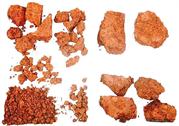Soil Structure: Peds and the Types of Structural Units
Peds: the building blocks:
Soil is made up of particles and small aggregates, these can clump together to form larger aggregates (peds) which are the 'building blocks' of the soil.
Soil structure is the:
Types of Structural Units:
Soil aggregate
A general term for any distinct lump or clumping of soil particles, including peds, casts, clods or fragments.
Ped
An aggregate formed in the soil and may be an aggregation of smaller peds and is:
- separated from other similar aggregates by an obvious pattern of cracks or partings,
or- has distinct surfaces over at least one-half of the aggregate
or- has coatings over at least one-half of its surface.
Clod
An aggregate 100 mm or more in length and formed by soil disturbance such as cultivation.
Fragment
An aggregate less than 100 mm in length and formed by soil disturbance such as cultivation
Cast A ped of biological origin e.g. a worm cast.
refer to flow diagram below, for the identification of individual peds, casts, clods and fragments
 |
|
Soil Structure Samples on Tray
|
|
 |
size, |
 |
shape |
 |
degree of aggregation (if any) of the structural units (peds, clods), |
 |
the way they are arranged in the soil, |
 |
and includes the spaces between and within the aggregates. |